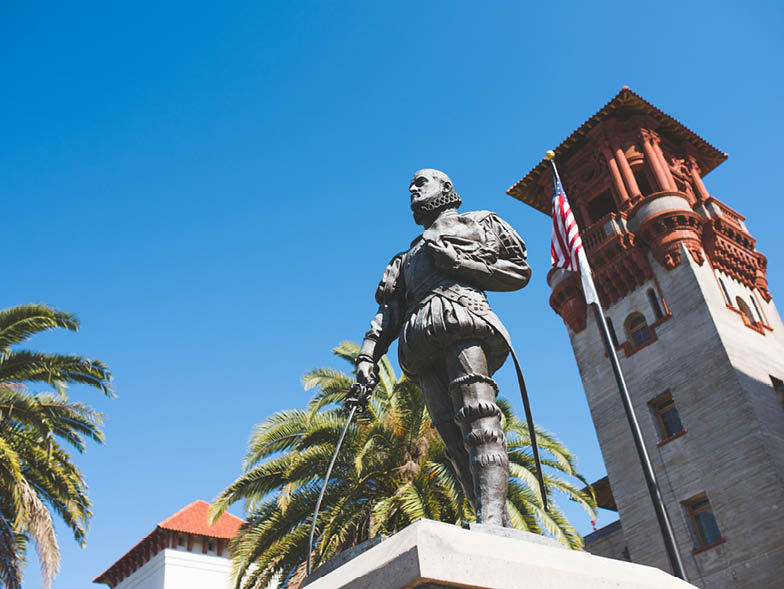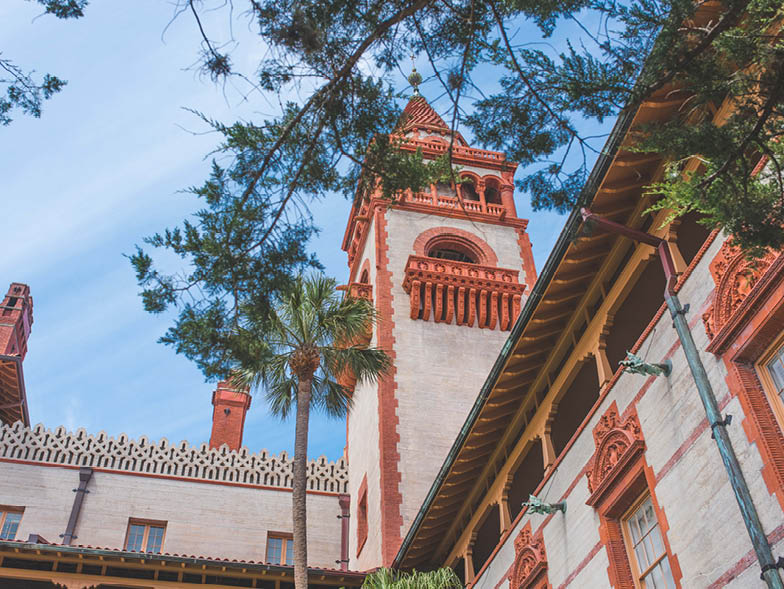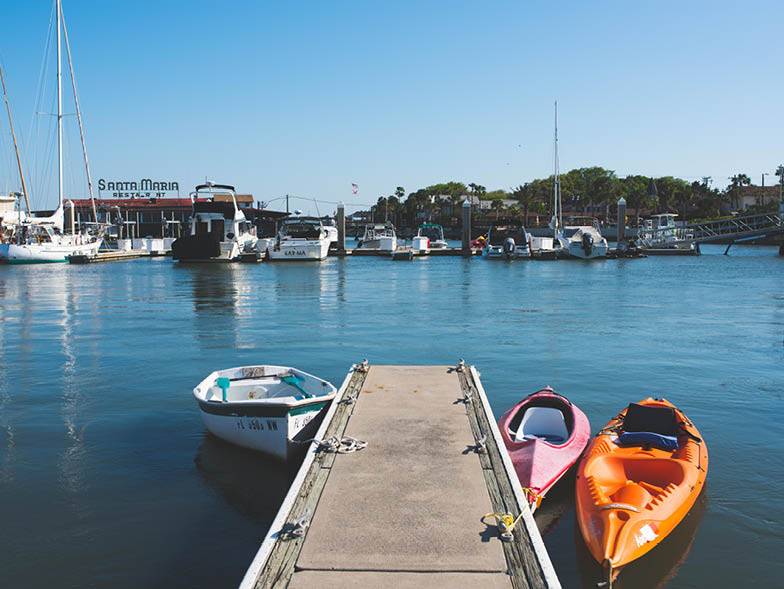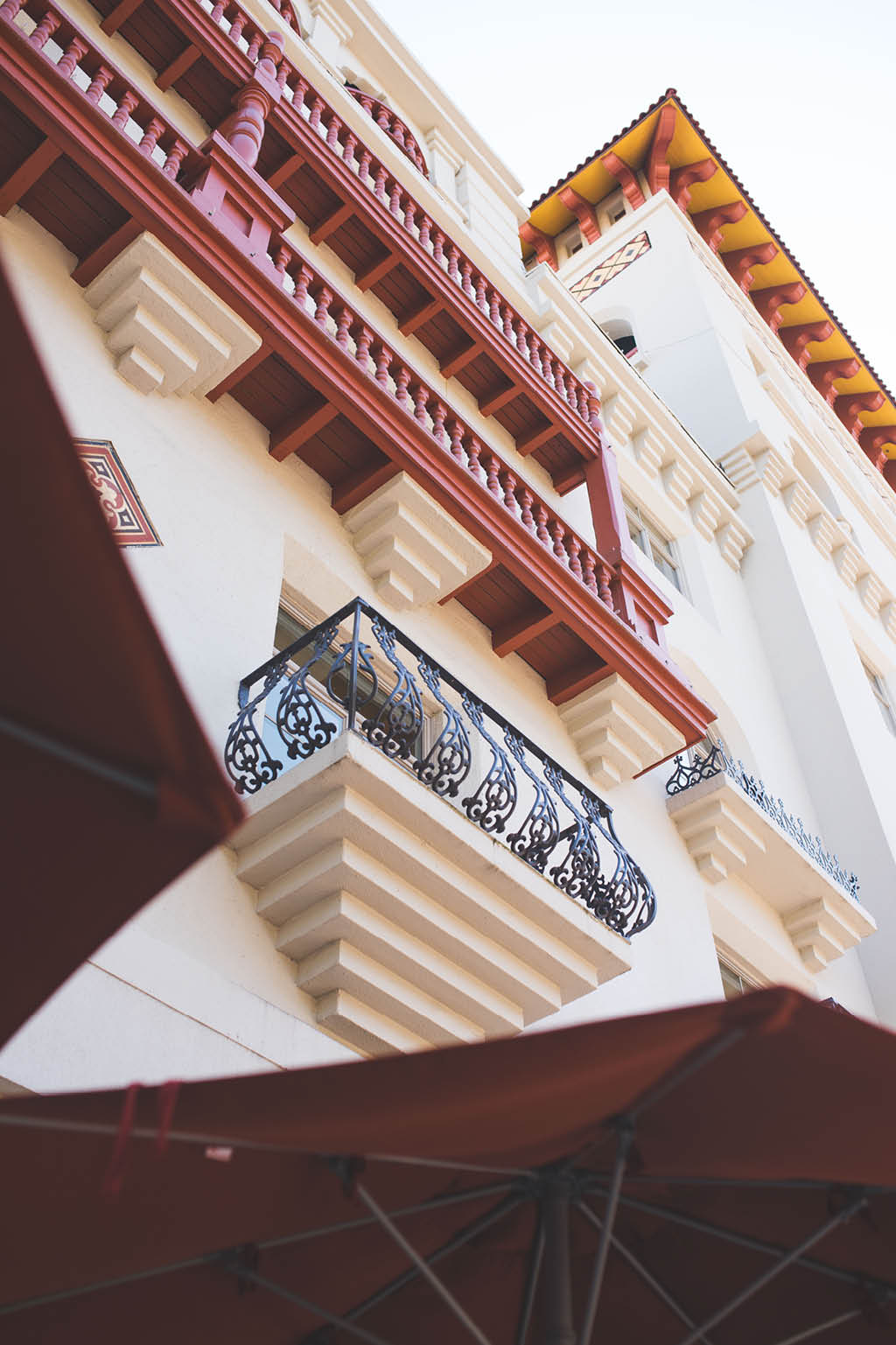At the Corner of History and Vacation
Amid more popular Florida tourist destinations lies a gem on the east coast of the state. Saint Augustine, known as the oldest city in the country, is a charming getaway with centuries-old landmarks, delicious food, and a relaxing, welcoming vibe—the perfect travel destination for young and old alike.
Voluminous yellow pots host happy plants and flank a standalone shack of sorts at the corner of Cuna and Charlotte Streets in Saint Augustine, Florida. This rustic hut is home to Crucial Coffee Cafe, where bright red benches and lovingly frayed tablecloths of the same hue invite summer tourists to sit down and indulge in a cool treat or a morning cup of joe. A chalkboard menu suspended from the ceiling announces the daily offerings and flavors of ice cream and Italian ice. “A scoop of watermelon ice, please,” I request to the woman at the counter, and she bends down and around to reach the freezer in the tiny kitchen space. Perched on a metal chair with a pillow cushion, I savor spoonfuls of chilled sweetness as the breeze floats in through the windows and a set of double French doors painted fire engine red. With its cobblestoned streets, Spanish Renaissance Revival-style architecture, and outdoor dining everywhere you turn, sun soaked Saint Augustine is the picture of Floridian bliss—with a rich history to boot.

Spanish explorer Juan Ponce de León discovered Florida in 1513, naming it in honor of the Easter season and the Spanish festival of flowers. More than fifty years later, Pedro Menéndez de Avilés arrived with ten ships and 800 soldiers and their families to settle Saint Augustine. In the Siege of Saint Augustine in 1702, the British were unable to conquer Castillo de San Marcos, the fortress, but they burned the rest of the (mostly wooden) city to the ground. The fort was protected by coquina, a limestone consisting almost entirely of shelly fossils. This material was quite porous and ideal for withstanding cannon shots, which absorbed into the walls of the fort instead of shattering them. This coquina fort was preceded by a series of wooden forts that didn’t fare well against the French and British, who wanted Florida for themselves. Today, Castillo de San Marcos is a popular destination forvisitors to Saint Augustine. It’s also the oldest European fort built of stone blocks in the United States. Construction began on October 2, 1672, and was completed two decades later in 1695. The self-guided tour has plenty to read, but the outdoor lecture explaining the different artillery is a must. Visitors learn about six kinds of shot with various uses, like glass shot, canister shot, and spike shot.
Saint Augustine as a tourist destination began when wealthy oil entrepreneur Henry Flagler came to visit the city with his second wife. He thought the city was charming but lacked proper accommodations and an upgraded railroad system. Believing Florida had the potential to attract tourists, he gave up day-to-day involvement in the Standard Oil Company so he could focus his attention on creating a luxury destination. His Florida East Coast Railway began with the purchase of the Jacksonville, Saint Augustine, and Halifax River Railroad. The tracks were modernized, and he extended the railroad from Jacksonville to Key West.



Next on Flagler’s list was the Ponce de León Hotel, which held his vision for luxury accommodations in Saint Augustine. He brought in two New York architects, John Carrère and Thomas Hastings, to manifest this dream into reality. Built in the style of the Spanish Renaissance Revival, the 540- room hotel opened on January 10, 1888. It was constructed from poured concrete and featured two towers on each side of the building filled with water—8,000 gallons of hot water and 8,000 gallons of cold water. The Ponce de León was also one of America’s first electrically powered buildings. Thomas Edison and Flagler were friends, and Edison Light Company was employed to keep the hotel’s more than 4,000 lightbulbs lit up. Flagler had to hire additional staff to operate the light switches in the rooms because guests were unfamiliar with electricity and feared being shocked.
Guests of the hotel were required to pay for the season from November to May, regardless of how long they actually stayed. Six months or one night, everyone paid $4,000 to stay. For a couple, that would equate to a quarter of a million dollars in the present day!
A highlight of the hotel is surely the beautiful rotunda, which features a floor of hand-laid African tile. Flagler believed perfection should only be reserved for God and instructed the tile setters to make a mistake in one of the mosaics on the floor. If you look closely, you’ll see each black triangle has a corner of white except for one, which is all black. Flagler also hired artist George W. Maynard to create the murals in the rotunda and dining room, which took him eighteen months without help. The spirit of Old Spain isrepresented in the panels, which reference the four elements: water, fire, earth, and air; as well as the four figures of exploration: adventure, discovery, conquest, and civilization.



The dining room features seventy-nine Tiffany stained-glass windows, reputed to be the largest private collection of Louis Comfort Tiffany glass in its original location in the world. In 1968, the hotel became a part of Flagler College, and now college students enjoy their meals in opulent surroundings. Some of the dining chairs are even originals. Flagler College was added to the US National Register of Historic Places
in 1975.
Flagler also commissioned the Alcazar Hotel, designed by the same New York architects who were responsible for the Ponce de León Hotel. The hotel was home to a steam room, sulfur baths, a three-story ballroom, and the world’s largest indoor swimming pool. The hotel shuttered in 1932 and was purchased by Otto C. Lightner in 1947 to house his collection of Victorian-era pieces. The Chicago publisher turned it over to the city of Saint Augustine, which turned it into the Lightner Museum. The museum occupies the rear section, and the pool area is now home to shops and the Cafe Alcazar, with a sloping floor that would have been the shallow end to the deep end. The second floor is full of cut glass and work by Louis Comfort Tiffany, while the third floor features paintings, sculptures, furniture, and expanses of open space and wood floors. Peer out over the railing for a view of what was the indoor pool. If you let your imagination run wild, you can almost hear the splash of a diver jumping from the third floor.
While there, don’t miss the music demonstration performed twice daily, with instruments from the 1870s to the 1920s displayed and played. The German orchestrion plays the sound of six instruments from a giant cardboard sheet.
After the Lightner Museum, hop onto the Old Town Trolley tour, a convenient way to see the whole city, with twenty-three stops, more than one hundred sights to see, and continuous commentary to get visitors acquainted with the city and its history. Leave some time to go through the Saint Augustine History Museum and read the timeline of early settlers in Florida. British colonists in the eighteenth century grew cotton, rice, and indigo. They also raised cattle and were called Florida Crackers because of the sound their bullwhips made. Ever wonder how much groceries cost in 1909? The history museum is full of interesting facts about the past, including the cost of a jar of peanut butter.

Hop off near Saint George Street for a long stretch of shopping, from chocolates to art glass to vintage clothing. Turn onto Hypolita Street for more shops and eateries. Catch some live music and barbecue at Scarlett O’Hara’s, or hang out on the porch and sip a Rosemary’s Lemonade. After lunch, walk back down Hypolita Street and hang a left onto Charlotte Street, where you’ll find the famous Hyppo Gourmet Ice Pops shop, which offers cool flavors like pineapple cilantro, blood orange cheesecake, and plum mint. This has become a Saint Augustine tradition. Walk a bit farther, and turn left on Cuna Street, where you’ll find the Gourmet Hut, a beautiful outdoor restaurant that shares space with neighboring Crucial Coffee Cafe. When the sun goes down, this alfresco dining spot turns into a fairy tale, with strings of rope lights overhead and a keyboard player near the sidewalk. Its offerings change every day, and staff will bring the chalkboard menu to you so you can order tableside. Another delicious spot for dining is The Floridian, a laid-back eatery on Spanish Street that boasts an outdoor front porch nd a larger indoor space. The food is definitely southern-inspired, with options like fried green tomatoes and pork belly caprese.
A stroll along the water is a welcome respite from the more crowded streets in town. Go past Ponce de León Circle onto Avenida Menendez to walk along the Matanzas River. You can also venture into the municipal marina where El Galeón—a five-deck replica of a Spanish galleon from the colonial period—is periodically docked. Ships like this would have sailed Florida’s waters in the sixteenth and seventeenth centuries, but El Galeón travels up and down the East Coast. El Galeón is maintained by a crew of twenty-eight who operate the seven sails on three masts. Along the pier, you can nod hello to the locals hanging out in their boats, smile at the clever boat names, and feel the camaraderie of the boating community.
For sunset chasers, hop in the car and drive to a restaurant called Saltwater Cowboys. The food is reportedly delicious, though I only made it as far as the parking lot that overlooked marshland and the horizon, where the Florida sun dipped lower and lower, lighting up the sky in cotton candy pink and clementine orange.
There are quite a few winners for accommodations in Saint Augustine, and the Inn on Charlotte is one such gem. Built in 1918 for a local attorney, this brick home ushered in the Roaring Twenties, an era of modern technology and a more carefree lifestyle. It was restored in 2003 and furnished with quality antiques and reproductions. The porch is ideal for lazy days in the shade with a book and a glass of lemonade from the refrigerator. Breakfast is a two-course affair, with a chilled soup or fruit as the appetizer. The main courses vary from citrus French toast to eggs Benedict casserole to Swiss cheese quiche.
The best thing about Saint Augustine is the way it beckons you to wander the quaint streets, sneak into an outdoor patio for a caprese salad and some acoustic guitar, and manage the drips of an ice cream cone on a sunny day. The Spanish architecture flavors the town with a romantic spice, and you might wish you had hand to hold as you catch the riffs of blues music floating out on wisps of cigar smoke from Stogies Jazz Club. History and relaxation meet and stand together for a moment in the streets of Saint Augustine, reminding you to breathe.
For more info, visit www.floridashistoriccoast.com.






















